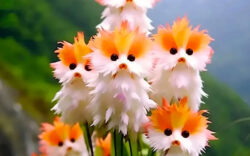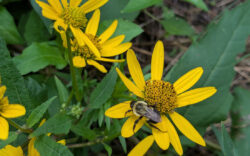With October comes a new, less intense round of gardening duties. Most chores can wait another week, or month, before you need to tackle them—except for saving any tender plants from the frost. Hopefully, you did that already, since the first frost will have come and gone by the time this article prints.
Bring in Your Indoor Plants: If your indoor plants live outdoors in the summer, it’s past time to bring them inside. Some, like the foxtail fern, can survive a short frost with little to no consequences. Tropics-loving plants like the snake plant, sansevieria, could sustain some ugly frostbite. Don’t worry, you (probably) haven’t killed it! You’ll want to remove any damaged tissue; usually mushy, discolored spots that show up with warming temperatures. Bring the plant indoors as soon as possible. Make a plant-hospital spot with warmth and its favored level of lighting where you’ll remember to check on it daily. I use the top of my refrigerator for this purpose. The kitchen is one of the warmer rooms in my house, and the indirect light from the windows is perfect for shade-loving leaves.
Avoid fertilizing any winter-dormant indoor plants at this time. If you’re looking for a great show from a winter-bloomer, like the Christmas cactus, throwing additional compost or some fertilizer in the pot could help encourage buds. Re-potting should wait until the spring, when most indoor plants start vigorous growth again. That said, you’re going to have to look at those pots for the next five months. If you hate it, change it.
Pick the Right Fertilizer: I am not a lawn person. But I am a person who hates seeing folks waste money. And I’ve seen plenty of lawn fertilizer products recently that look both financially and environmentally suspect.
Here in Georgia, we grow warm-season grasses like Bahia grass, Bermuda grass and St. Augustine grass. These grasses go dormant in the winter. Many “For Fall Lawns” products contain a lot of nitrogen. Nitrogen is the first number in the three listed numbers on any fertilizer container. Nitrogen promotes leaf growth. While it may green up your lawn before a few frosts, that growth will come at the expense of developing hardy, healthy roots for the dormant months.
Instead, check out the middle number, the phosphorus. Phosphorus promotes root growth. I’ve seen quite a few “For Fall Lawns” with high nitrogen numbers and low or zero phosphorus. Avoid these. Winter rains will wash most of the nitrogen away before your grass can absorb it, and instead it will pollute local waterways. Even if you don’t care (or believe) in the environmental impact, it’s wasting money to dump nitrogen on a lawn that can’t absorb it.
Temperature matters, too. Though we’ve hit a few chilly nights, warm-weather grass generally goes dormant when soil temps hit below 65 degrees. According to the University of Georgia Weather Network, the Athens area measures approximately 75 degrees for soil temp at 2 and 4 inches, so there’s still a window to fertilize your lawn.
Assess whether you need any fertilizer at all with an annual $8 soil test. Bags available at your nearest extension office.
Mulch Update: I wrote a column last year about the importance of mulching in the fall and mentioned an experiment with coconut flakes. My husband works at Creature Comforts Brewing Co., and he brought hundreds of pounds of coconut home after it was steeped in last year’s Koko Buni. The pleasantly malty smell soured after a few days and the coconut turned a light brown to a dark brown as it rotted. The major drawback was the dogs—they ate mouthfuls of the stuff! It led to a few gross doggy stomach aches before they stopped mulch munching. Most of the ornamentals responded well in the spring, growing leaps and bounds better than with the previous year’s wood chips. The biggest winner: The roses. I don’t know what nitrogen/phosphorus/potassium magic the rotten coconut flakes contained, but the roses responded with armfuls of blooms. Those bushes had enough energy to survive peak Japanese beetle time and grow more healthy buds that looked like flowers instead of Swiss cheese.
I’m not suggesting you throw coconut flakes on your roses. I am suggesting that some organic debris you might see as waste could be a lovely unconventional mulch in disguise.
Like what you just read? Support Flagpole by making a donation today. Every dollar you give helps fund our ongoing mission to provide Athens with quality, independent journalism.










